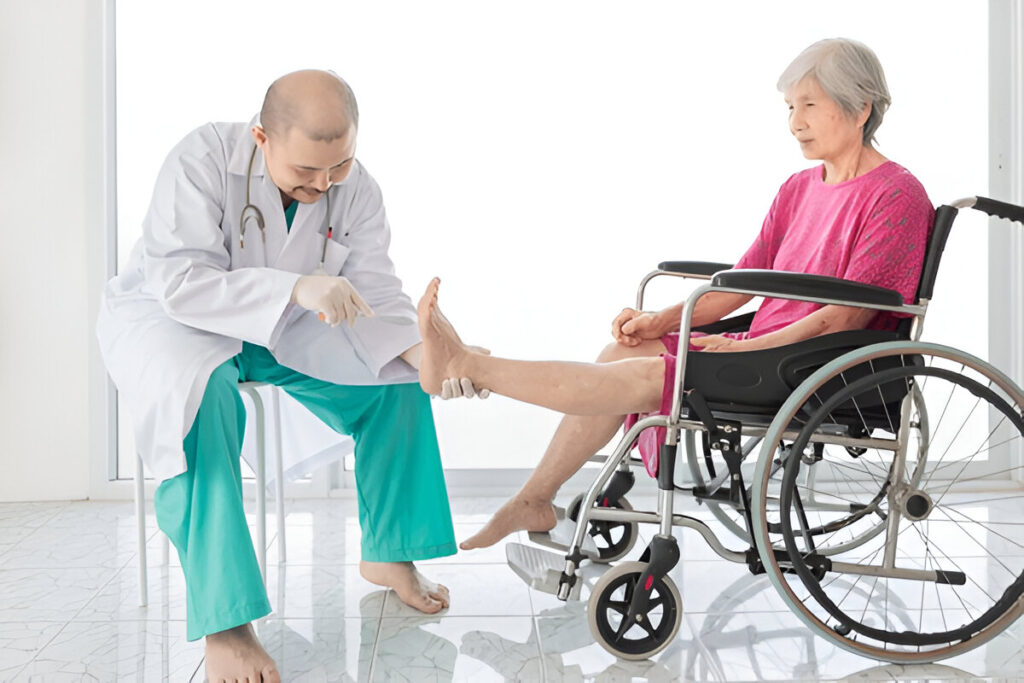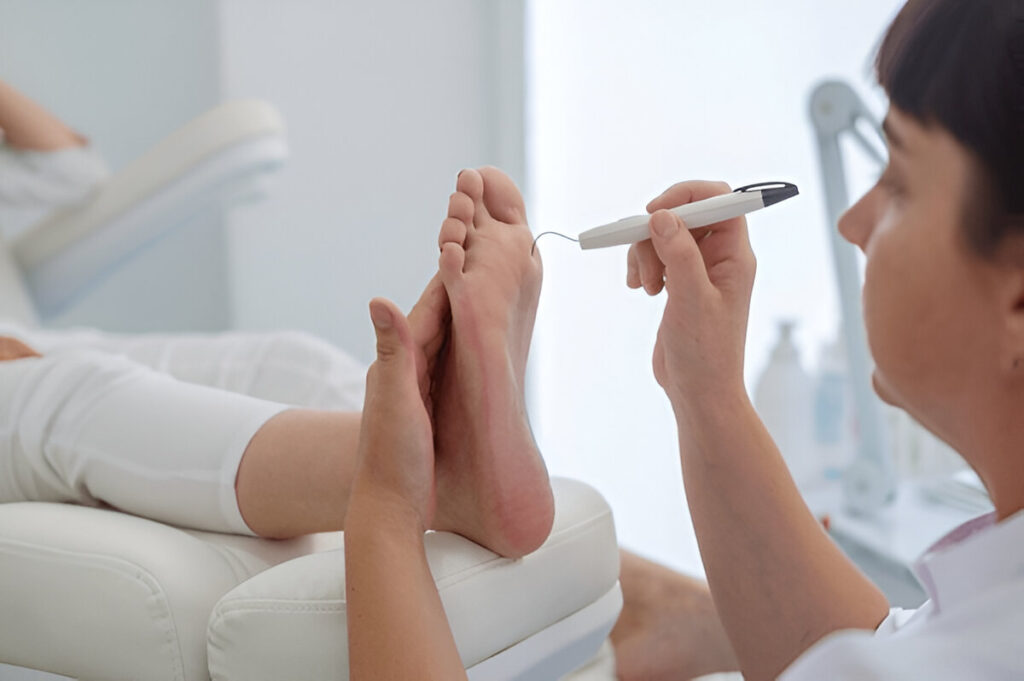Every year, thousands of people with diabetes face the frightening possibility of losing a foot or leg to amputation. The truth is that early diabetic foot care saves limbs by detecting problems before they spiral into infections or severe wounds. Diabetic patients often experience nerve damage, poor circulation, and slow healing, which makes their feet especially vulnerable. Without timely attention, even a small blister or cut can progress into a dangerous ulcer that puts an entire limb at risk.
The encouraging news is that with regular check-ups, proactive treatment, and simple lifestyle adjustments, the majority of amputations can be prevented. Clinics offering diabetic foot care services emphasize education as much as treatment—teaching patients how to monitor their feet daily, recognize warning signs, and seek medical help immediately when something feels wrong.
At our wound care center, we’ve seen how quick action makes the difference between saving a limb and facing a life-altering surgery. Throughout this article, we’ll explain exactly why early care matters, outline the steps patients can take at home, and explore the medical treatments that support limb preservation. For further reading, see our blog on wound healing tips, which covers related strategies.
The Link Between Diabetes and Foot Complications
To understand why early diabetic foot care saves limbs, it helps to know how diabetes impacts the body. Elevated blood sugar levels gradually damage nerves (neuropathy) and blood vessels (peripheral arterial disease). Neuropathy reduces sensation, so patients may not feel cuts, blisters, or burns. At the same time, poor circulation makes it harder for those injuries to heal.
This combination creates a perfect storm: wounds go unnoticed, infections spread quickly, and tissues struggle to recover. If untreated, these infections may reach bone or deep tissue, requiring amputation to prevent further harm.
That’s why specialized clinics stress routine diabetic foot exams and vascular assessments. By identifying reduced sensation or poor blood flow early, interventions can be applied before complications arise.
For a deeper dive, check out our blog on understanding neuropathy, which explains how nerve damage sets the stage for foot problems. Recognizing this link early empowers patients to act before small issues become irreversible.

Why Early Intervention Is the Key to Limb Preservation
When experts say early diabetic foot care saves limbs, they mean it literally. The earlier a problem is caught, the easier it is to treat. For example, a small blister discovered during a daily self-check can be cleaned, protected, and healed within days. If ignored, that same blister might evolve into a deep ulcer, requiring hospitalization or surgery.
Intervening early also means that advanced treatments—such as custom orthotics or wound dressings—can be used preventively rather than reactively. This proactive approach minimizes hospital stays and reduces overall costs.
The key is to create a partnership between the patient and their care team. Regular visits to a podiatrist or wound specialist help ensure that even minor changes are noticed and addressed. For inspiration, read our blog on preventing diabetic ulcers, which outlines small, actionable habits that make a huge difference.
Daily Foot Checks: A Simple Habit That Saves Limbs
One of the simplest but most effective habits is a daily foot check. Patients should inspect their feet every morning or evening for cuts, swelling, redness, or changes in skin color. Because neuropathy reduces pain sensation, visual inspection becomes critical.
Using a mirror to check the soles of the feet—or asking a family member for help—ensures no area is missed. Moisturizing dry skin, trimming nails carefully, and wearing clean, well-fitting socks also help prevent issues.
Clinics offering preventive diabetic foot care often provide educational guides or checklists to make this habit easier. These small routines are part of why early diabetic foot care saves limbs—because prevention always outperforms emergency treatment.
For practical advice, explore our blog on daily diabetic foot care tips, where we explain how five minutes of attention each day protects mobility for years.
Choosing Proper Footwear for Protection
Improper shoes are one of the leading causes of ulcers in diabetic patients. Shoes that pinch, rub, or lack support can cause blisters that quickly turn dangerous. To prevent this, clinics recommend diabetic-friendly footwear, which provides cushioning, support, and minimal friction.
Custom orthopedic shoes or inserts can be fitted for patients with unique needs, such as flat feet or pressure points. Patients should avoid walking barefoot, even indoors, as unnoticed injuries can occur from sharp objects or hot surfaces.
The right footwear not only prevents injuries but also improves balance and reduces the risk of falls. By incorporating this step, patients prove the principle that early diabetic foot care saves limbs in daily life.
For more, read our blog on diabetic shoe selection, which walks through styles and features worth investing in.
The Role of Professional Foot Exams
While self-checks are vital, professional evaluations add another layer of protection. Annual or semi-annual visits for diabetic foot exams allow clinicians to test nerve sensitivity, circulation, and skin health.
During these visits, podiatrists may identify problems invisible to patients, such as fungal infections, ingrown nails, or early vascular disease. They also provide treatments like callus removal or nail trimming that reduce ulcer risks.
Professional care ensures that warning signs are caught before they become emergencies. This is why early diabetic foot care saves limbs—because professionals see what patients cannot.
For insight into what happens during an exam, read our blog on foot screening importance.
How Wound Care Centers Prevent Amputation
When wounds do occur, specialized wound care centers play a critical role in limb preservation. They offer advanced treatments like debridement, dressings, offloading devices, and infection control, which speed healing.
By addressing wounds aggressively and consistently, these centers dramatically reduce the likelihood of amputation. Patients benefit from a team approach, where podiatrists, vascular surgeons, and nurses collaborate on care.
This model proves again that early diabetic foot care saves limbs—because rapid referral to wound specialists turns a dangerous situation into a manageable one.
Learn more in our blog on wound clinic benefits, which explains the technologies used to save limbs every day.
Managing Blood Sugar to Protect Feet
Good foot care isn’t just external—it begins with controlling blood sugar. High glucose levels damage blood vessels and nerves, the root cause of many foot complications. By working with a diabetes care team to maintain A1C targets, balanced diets, and exercise routines, patients protect their feet from within.
Early intervention through lifestyle changes proves that early diabetic foot care saves limbs by addressing the condition holistically. Clinics may also recommend routine lab work, medication adjustments, and nutrition counseling.
For more, see our blog on diabetes and circulation, which explains how internal health supports external foot care.
The Importance of Vascular Health
Poor circulation is a leading factor in delayed healing and amputation risk. Vascular specialists assess blood flow using Doppler testing or ankle-brachial index measurements. If circulation is compromised, treatments such as angioplasty, stenting, or bypass surgery may restore blood supply.
Integrating vascular care into diabetic management ensures that wounds heal efficiently. This is another reason why early diabetic foot care saves limbs—because circulation can be restored before tissue loss occurs.
Learn more from our vascular care services and related blog on blood flow and healing.
Infection Control and Antibiotic Use
Infections are the tipping point where small wounds become life-threatening. Early intervention with antibiotics, sterile dressings, and infection monitoring prevents escalation. Clinics often culture wounds to target treatment precisely.
Patients should seek medical care at the first sign of redness, swelling, or discharge. Delays can allow infections to spread to bone, increasing amputation risk. This is why proactive attention proves the truth: early diabetic foot care saves limbs.
For additional strategies, see our blog on infection prevention.
Lifestyle Adjustments That Support Limb Preservation
Beyond medical treatments, lifestyle choices support long-term limb health. Quitting smoking, exercising regularly, and maintaining healthy body weight all improve circulation. Even simple activities like daily walking—when done safely in proper shoes—boost blood flow to the legs and feet.
Diet plays a role too. Consuming foods rich in antioxidants and healthy fats supports vascular health. These adjustments reinforce the principle that early diabetic foot care saves limbs not just through medicine, but through everyday decisions.
Explore our blog on lifestyle tips for diabetics, which outlines practical changes that protect feet.
The Emotional and Financial Impact of Amputation
Preventing amputation isn’t only about physical health. Losing a limb affects mental well-being, independence, and financial stability. The costs of prosthetics, rehabilitation, and lost work time can overwhelm families. Emotionally, patients often struggle with grief, depression, and reduced mobility.
By emphasizing prevention, clinics help patients avoid this life-altering outcome. This is why communities stress that early diabetic foot care saves limbs—because it saves dignity, freedom, and stability as well.
For real stories, see our blog on patient success with foot care.
The Role of Multidisciplinary Care Teams
One of the strongest reasons why early diabetic foot care saves limbs is the rise of multidisciplinary care teams. Diabetes affects multiple systems in the body, and foot problems often involve a complex interplay between nerve health, blood flow, wound care, and infection control. No single specialist can address all these issues effectively. That’s why clinics increasingly bring together podiatrists, endocrinologists, vascular specialists, wound care nurses, and nutrition counselors into one coordinated plan of care.
This approach ensures that patients receive a comprehensive evaluation rather than fragmented advice. For example, a podiatrist may identify a slow-healing ulcer, but a vascular surgeon can restore circulation, while a dietitian provides nutrition strategies to speed recovery. By having specialists communicate and coordinate treatment, the risk of oversight is minimized.
Patients also benefit emotionally, as care teams provide consistent education and encouragement. Having multiple professionals emphasize why daily monitoring, strict blood sugar control, and preventive exams matter reinforces adherence. Research consistently shows that patients who engage with multidisciplinary teams have fewer hospitalizations, faster healing times, and significantly reduced amputation rates.
For a real-world look at how this teamwork approach saves lives, see our blog on collaborative diabetic care. In practice, diabetic foot care isn’t just about the feet—it’s about the whole person. Holistic support is what truly makes early intervention life-saving.

Technology and Innovations in Diabetic Foot Care
Modern medicine continues to prove that early diabetic foot care saves limbs by integrating innovative technologies into routine practice. Devices such as infrared thermography cameras allow clinicians to detect hot spots on the feet—areas of inflammation that may develop into ulcers—long before they are visible to the naked eye. Similarly, continuous glucose monitoring systems help patients stabilize blood sugar, indirectly protecting foot health.
Telemedicine services are another breakthrough. Patients can now send photos or video consultations to their wound care specialists without leaving home. This eliminates delays in treatment, especially for those with limited mobility. Pressure-sensing insoles are also emerging, alerting patients in real-time when certain areas of the foot are under dangerous stress.
Advanced wound treatments, such as negative pressure therapy, bioengineered skin grafts, and oxygen therapy, further improve healing outcomes. These innovations demonstrate how combining traditional practices with technology creates a powerful safeguard against limb loss.
Importantly, technology empowers patients as much as providers. By engaging with apps, wearable devices, and remote monitoring, individuals take ownership of their health and become active participants in prevention. For a deeper look at the role of digital health in diabetic care, see our blog on telehealth and diabetes management.
Conclusion: Building a Lifelong Foot Care Plan
The message is clear: early diabetic foot care saves limbs. By combining daily self-checks, professional exams, vascular assessments, proper footwear, and lifestyle changes, most amputations are preventable.
Patients who build a lifelong plan with their care team ensure lasting mobility and independence. Clinics offering comprehensive diabetic care are partners in this journey, providing resources, education, and advanced treatments when needed.
To begin your path toward protection, schedule an appointment through our contact page. For further reading, browse our blog library, where we cover wound care, prevention strategies, and lifestyle adjustments in greater detail.
Contact Information
Don’t wait until a minor foot issue becomes a major problem. Contact us today for specialized care tailored to your needs.
Toms River Office
📍 664 Commons Way Building 1
Toms River, NJ 08755
📞 Phone: (732) 557-9900
📧 Email: gsfagroup@gmail.com
Belleville Office
📍 1 Clara Maas Drive
Belleville, NJ 07109
📞 Phone: (973) 450-3035
🌐 Website: gsfagroup.com
Podcast: Play in new window | Download

0 Comments